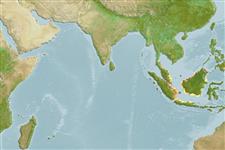>
Atheriniformes (Silversides) >
Phallostethidae (Priapiumfishes)
Etymology: Phallostethus: Greek, phallos = penis + Greek, stetho, stethion = brest; literal = to prick a little breast (Ref. 45335).
Environment: milieu / climate zone / depth range / distribution range
Ekologi
laut; payau. Tropical
Western Pacific: Borneo.
Size / Weight / umur
Maturity: Lm ? range ? - ? cm
Max length : 2.7 cm SL jantan/; (Ref. 12769); 2.8 cm SL (female)
deskripsi pendek
Morfologi | Morfometrik
Differs from all congeners by having the following characters: second ctenactinium with eight serrae in adult males; 28 caudal vertebrae with no sexual dimorphism in the number of precaudal vertebrae; 28 or more teeth on paradentary; all males are sinistral (Ref. 90869).
Fertilization is internal and eggs are attached to the substrate via adhesive filaments (Ref. 43413).
Pelvic fins in males are modified to form part of a complex thoracic clasping organ (Ref. 205).
Parenti, L.R., 1996. Phylogenetic systematics and biogeography of phallostethid fishes (Atherinomorpha, Phallostethidae) of northwestern Borneo, with description of a new species. Copeia 1996(3):703-712. (Ref. 12769)
Status IUCN Red List (Ref. 130435)
ancaman kepada manusia
Harmless
penggunaan manusia
informasi lanjut
Umur / SaizPertumbuhanpanjang-beratpanjang-panjangukuran frekuensiMorfometrikMorfologiLarvaDinamika larvapemulihanKelimpahanBRUVS
AcuanBudidaya airprofil budidaya airStrainGenetikaElectrophoresesDiturunkanPenyakit-penyakitPengolahanNutrientsMass conversion
mitraGambarStamps, Coins Misc.Suara-suaraCiguateraKecepatanTipe renangArea insangOtolithsOtakPenglihatan / visi
Alat, peralatan
laporan khas
muat turun XML
Sumber internet
Estimates based on models
Preferred temperature (Ref.
123201): 28.2 - 29.1, mean 28.7 °C (based on 198 cells).
Phylogenetic diversity index (Ref.
82804): PD
50 = 0.6250 [Uniqueness, from 0.5 = low to 2.0 = high].
Bayesian length-weight: a=0.00389 (0.00180 - 0.00842), b=3.12 (2.94 - 3.30), in cm total length, based on all LWR estimates for this body shape (Ref.
93245).
Trophic level (Ref.
69278): 3.1 ±0.3 se; based on size and trophs of closest relatives
Fishing Vulnerability (Ref.
59153): Low vulnerability (10 of 100).
